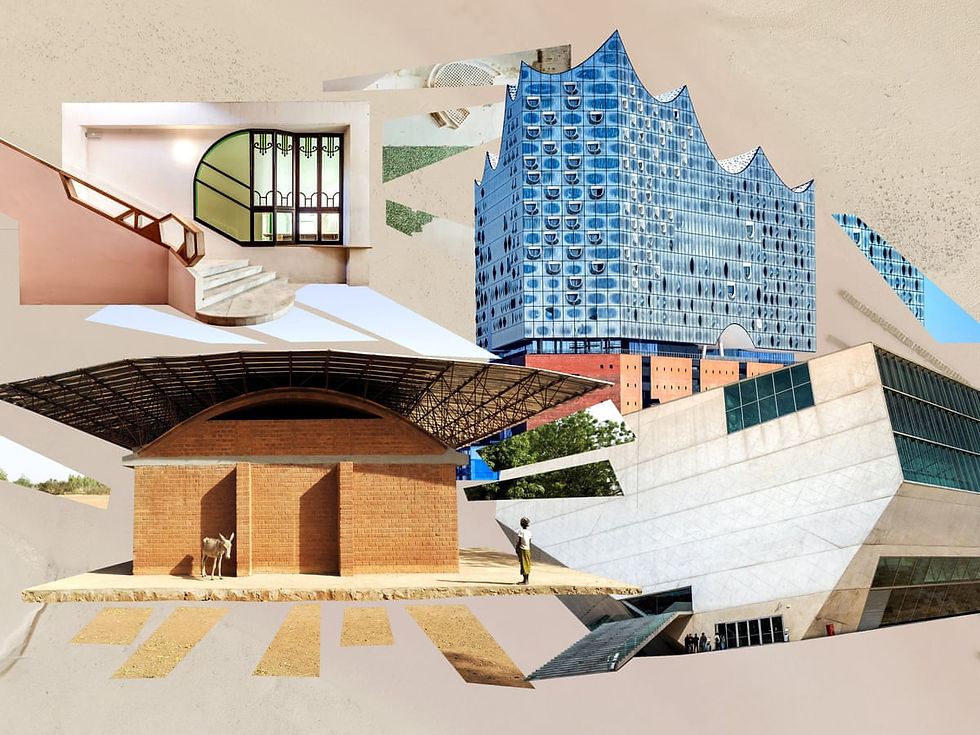Towards A Futurist Leap in the 21st Century
- sidrakhokhar8
- Apr 16, 2022
- 4 min read

Wainwright, O. (2019). The best architecture of the 21st century. [Illustration]
Although the 21st century brings with it a plethora of architectural possibilities due to the wide range of options now available that can cater to almost any type of architectural design being physically executed, the question of the nature of the progression of the Futurist or Modern style remains. How can one ascertain which style seems to have progressed more than the other and which one plays a more integral part in synthesizing the existing social fabric?
Futurism and Modernism are both architectural styles that are interrelated since Futurism was a by-product of the Modern ideals which the architects and designers wanted to consciously shift away from. However, it is important to also comprehend the fact that every architectural style movement seemed to overlap each other regarding time. The Modernists and Futurists seem to be progressing simultaneously with regard to their ideologies and their physical implementations. Despite this overlap of architectural theory and practice, one cannot say that one style dominated the other in terms of its progress in the 21st century. Rather, as we will discuss further, these architectural styles emanated alongside each other to create a rich diaspora of built forms in the 21st century that caters to multiple thought processes and socio-cultural needs of the society globally.
Foraging Through the Concepts of Modernism

Carlo, S. (2019). Prayer Hall at Bait ur Rauf Mosque, Dhaka, Bangladesh. [Photograph]
Modernism as a progressive style in the 21st century would be extremely convenient to identify. The aesthetic appeal of minimalism paired with the utilitarian aspect is an easily adaptable approach. Futurism or Modernism can be argued to be both easily adaptable due to the technological advancements that have been made over time, however, Modernism seems to have evolved into what most scholars would call late modernism. Modernism being a celebration of the society stepping away from staunch historical nuances and academic standards, stands out remarkably in areas where the architectural visual language is purely based on traditional elements of architecture, especially in developing countries today. It can be argued that modernism has seen a shift away from its early ideals that helped it surface back in the 19th century, however, to confine it to a specific time is difficult. Historically, defining modernism has always been a controversial task. However, Modernism is seemingly a constant search for progress, a core architectural element of the modernist buildings that are emerging today in the 21st century.
Modernism with its straight lines and crisp geometry brings out a mindset that seeks order is perhaps a chaotic era. It appears that this architectural style is more dominant in the field of residential architecture where private clients are happy with minimalist retreats as their homes. Even in public buildings, this style seems to have been more progressive in the mid-20th century when skyscrapers seemed to emerge at the forefront of modern architecture, especially in America.
Futurism in the 21st Century- How far-reaching Are Its Effects?

Miletic, B. (2020). Walt Disney Concert Hall. [Photograph]
Futurism on the other hand in the 21st century is a continuation of the conceptual utopian architectural propositions which Antonia Sant’Elia instigated back in Italy during the early 20th century. This very continuation of the anti-historicist movement from the past tries to replicate dynamism, motion, and urgency in the 21st century through cutting-edge and out-of-the-box design strategies that are seemingly limitless in scope and scale. Inspired by technological innovations of building techniques and design, Futurist architecture in the 21st century appears to progress as iconic architecture globally. This utopian aspect and use of abstraction in form is a perfect combination to use whilst creating statement architectural buildings.
Architects such as Zaha Hadid, Santiago Calatrava, Buckminster Fuller, and, Rem Koolhas have set the tone for making Futurism an integral part of the 21st century. Through their daring work that speaks of dynamic architecture representing a clear-cut deviation from the concept of functionality that the Modernists celebrate, Futurist buildings have an aesthetic appeal that attracts the viewers’ eye and makes them ponder over the purpose of their existence.
The works of these architects have given the functional aspect of their buildings a secondary preference. The form of the building is the primary concern. The buildings as such substantiate the neo-futurist agenda of the belief that ‘Less is Bore’.
Carrying forward the conceptual utopian visions of Antonio Sant’Elia, Futurism as a progressive style in the 21st century is imminent through buildings with dynamic visual vocabulary. The megastructures that can be seen today with technological innovations that are reflective of the advanced age that we are in give the Futurist movement a far more progressive push in the 21st century than perhaps the Modernist philosophy.
Futurists in the 21st Century- How does their work stand out as progressive?
Buckminster Fuller’s geodesic dome with its simple yet complex form juxtaposed to create a spherical dome that was the first of its kind. Zaha Hadid’s Avant-Garde approach to her buildings such as the Haydar Aliyev Centre in Azerbaijan is another instance that set the tone for parametric architecture internationally where monumental forms were now being visualized in unorthodox ways.

Rose, G. (2016). Biosphere Environment Museum. [Photograph]

Iwan, B. HAC. [Photograph].
Santiago Calatrava’s unconventional design aesthetic when it comes to public spaces such as bridges is another example of how futurist architecture has changed the ideology behind typical public spaces in the 21st century. The idea of a bridge as just a means of connection has been changed drastically through its dynamic appearance to the masses.

BridgeInfo, (2012). Allamello Bridge. [Photograph]
Therefore, between Futurism and Modernism, one may argue that the former seems to have progressed far more than the latter in the 21st century today, primarily because it is reflective of the socio-cultural and economic fabric that is prevalent.




Comments